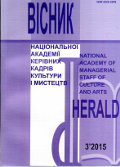STUDYING OF UKRAINIAN CHURCH EMBROIDERY OF BAROQUE PERIOD
DOI:
https://doi.org/10.32461/2226-3209.3.2015.138453Keywords:
Ukrainian church embroidery, baroque, historiographyAbstract
The actuality of studying the history of church embroidery – a unique variety of Ukrainian art, is conditioned by an ever-growing public interest in the national heritage. The purpose of this article is to review literature on the study of Ukrainian church embroidery of Baroque period. It has to determine the level of the subject’s study in historiography and to reveal unsolved aspects of the problem.
Interest in Ukrainian church embroidery became apparent in the second half of the 19th century. It was occasioned by the foundation of Church museums. In particular, they were The Church and Archaeological Museum of the Kiev Theological Academy (1872), the Poltava and Chernihiv eparchy antiquariums (1906). The pictures and descriptions of many church embroidery works were included in the Indexes of the museum collections. However, the huge amount of embroidery items, kept in the monastery and cathedral sacristies, were only partially covers by museumification process. Historical and statistical descriptions give some idea about participants of the meeting of individual dioceses or churches concluded, in particular, mytropolyt of Kiev Yevhenii (Bolkhovitinov), M. Malyzhenovskyi.
In the 1920s the first scientific researches of the history of Ukrainian Baroque embroidery appeared. Blossoming of research activity of M. Novitskaya belongs to this time (from 1928 to 1933 she was managed department of fabric and embroidery in the All-Ukrainian Museum Town, the museum association, created in the Kiev-Pechersk Lavra). In 1927 M. Novitskaya published an article "Dated orarions of Lavra Museum. 1640–1743". The main compositions, embroidery techniques and peculiarities of orarion decoration were described. K. Berladina – the Head of Department of Kharkiv State Art and Historical Museum in the early 1930s was significant scientific researcher. Two articles included in the cycle "Materials for the history of Ukrainian fine art embroidery" belong to her most notable publications. Ideological repressions of the 1930s forced M. Novytskaya and K. Berladina to stop their researches. However, their works on Ukrainian embroidery of XVII–XVIII centuries made a scientific foundation for the future study of the subject.
A next phase of interest in Baroque church embroidery in the 1960s was caused by preparation for edition "History of Ukrainian art". Two fundamental articles, dedicated to Ukranian folk and church embroidery, by scholars G. Logvin and M. Novytskaya were included in the second and fourth volumes of this edition. For the analysis of evolution of the Ukrainian church embroidery of XIII – the first half of the XVII century G. Logvin used archival and graphic sources, and also highly artistic works of embroidery gold from the Ukrainian and foreign collections. M. Novitskaya provided short historical the description of development of the Ukrainian church sewing during the specified period and concerned a question of production the subjects of church sewing in convents.
T. Kara-Vasylieva deepened and extended researches of her predecessors. Her fundamental monograph "Liturgical embroidery of Ukraine of the XVII–XVIII centuries. Iconography, typology, style" (1996) represented Baroque embroidery as an integral artistic phenomenon. Other important publications by T. Kara-Vasylieva are "Masterpieces of the church embroidery of Ukraine" (2000), part "Church embroidery of the XIV-XVIII century" in the edition of "History of Ukrainian embroidery" (2008).
An important contribution to the study of church Baroque embroidery was made by researchers of the leading Ukrainian museums. In 1970–1980’s according with cultural and educational activities of museums some items of church embroidery were exhibited and published in the thematic art albums and guidebooks. Since the independence of Ukraine an ever-growing public interest in the national heritage caused new opportunities for studying Ukrainian church embroidery. K. Hereles, V. Shcherbakova – members of stuff of the National Kyiv-Pechersk Historical and Cultural Reserve, made several publications on its largest in Ukraine collection of embroidery. V. Zaichenko, scientific researcher of the Chernigiv Historical Museum named after V. V. Tarnovsky, made catalog of Museum’s "Golden embroidery" collection. Works by R. Kosiv dedicated to a subject of the National Andrey Sheptytsky Museum’s in Lviv embroidery collection, were notable by high standard of scientific research.
Thus, review of historiography of Ukrainian church embroidery proves that the topic of Ukrainian XVII–XVIII centuries Baroque embroidery has repeatedly drawn the attention of art historians, scientific researchers and members of museum staff. At the same time we have insufficient information on the embroidered works from the collections of leading national museums. At the present time there is necessity of museum collections systematization and including into scientific circulation still unknown items of church embroidery.
Downloads
Published
Issue
Section
License
Authors who publish with this journal agree to the following terms:
1. Authors retain copyright and grant the journal right of first publication with the work simultaneously licensed under a Creative Commons Attribution License that allows others to share the work with an acknowledgement of the work's authorship and initial publication in this journal.
2. Authors are able to enter into separate, additional contractual arrangements for the non-exclusive distribution of the journal's published version of the work (e.g., post it to an institutional repository or publish it in a book), with an acknowledgement of its initial publication in this journal.
3. Authors are permitted and encouraged to post their work online (e.g., in institutional repositories or on their website) prior to and during the submission process, as it can lead to productive exchanges, as well as earlier and greater citation of published work (See The Effect of Open Access).


